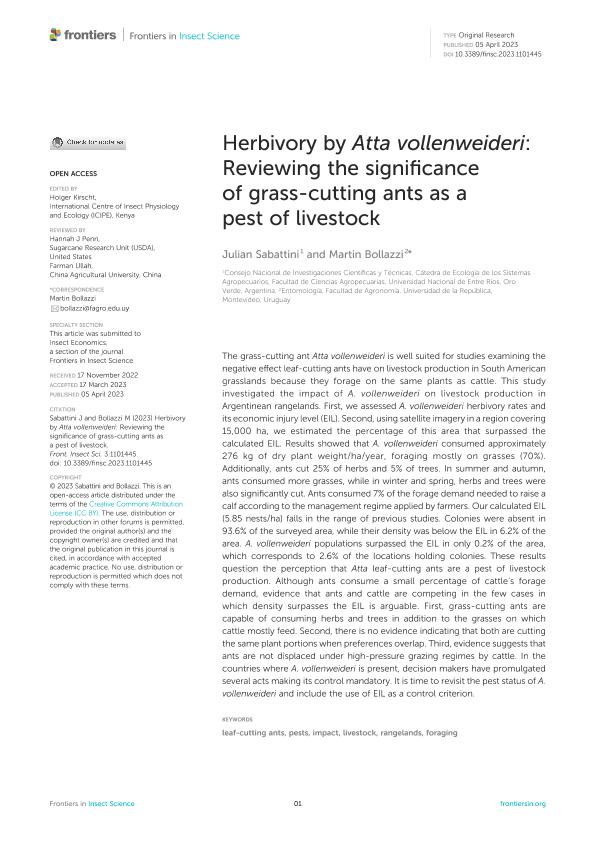Mostrar el registro sencillo del ítem
dc.contributor.author
Sabattini, Julian Alberto

dc.contributor.author
Bollazzi, Martin

dc.date.available
2023-12-13T14:14:13Z
dc.date.issued
2023-04
dc.identifier.citation
Sabattini, Julian Alberto; Bollazzi, Martin; Herbivory by Atta vollenweideri: Reviewing the significance of grass-cutting ants as a pest of livestock; Frontiers Media; Frontiers in Insect Science; 3; 1101445; 4-2023; 1-10
dc.identifier.uri
http://hdl.handle.net/11336/220126
dc.description.abstract
The grass-cutting ant Atta vollenweideri is well suited for studies examining the negative effect leaf-cutting ants have on livestock production in South American grasslands because they forage on the same plants as cattle. This study investigated the impact of A. vollenweideri on livestock production in Argentinean rangelands. First, we assessed A. vollenweideri herbivory rates and its economic injury level (EIL). Second, using satellite imagery in a region covering 15,000 ha, we estimated the percentage of this area that surpassed the calculated EIL. Results showed that A. vollenweideri consumed approximately 276 kg of dry plant weight/ha/year, foraging mostly on grasses (70%). Additionally, ants cut 25% of herbs and 5% of trees. In summer and autumn, ants consumed more grasses, while in winter and spring, herbs and trees were also significantly cut. Ants consumed 7% of the forage demand needed to raise a calf according to the management regime applied by farmers. Our calculated EIL (5.85 nests/ha) falls in the range of previous studies. Colonies were absent in 93.6% of the surveyed area, while their density was below the EIL in 6.2% of the area. A. vollenweideri populations surpassed the EIL in only 0.2% of the area, which corresponds to 2.6% of the locations holding colonies. These results question the perception that Atta leaf-cutting ants are a pest of livestock production. Although ants consume a small percentage of cattle’s forage demand, evidence that ants and cattle are competing in the few cases in which density surpasses the EIL is arguable. First, grass-cutting ants are capable of consuming herbs and trees in addition to the grasses on which cattle mostly feed. Second, there is no evidence indicating that both are cutting the same plant portions when preferences overlap. Third, evidence suggests that ants are not displaced under high-pressure grazing regimes by cattle. In the countries where A. vollenweideri is present, decision makers have promulgated several acts making its control mandatory. It is time to revisit the pest status of A. vollenweideri and include the use of EIL as a control criterion.
dc.format
application/pdf
dc.language.iso
eng
dc.publisher
Frontiers Media

dc.rights
info:eu-repo/semantics/openAccess
dc.rights.uri
https://creativecommons.org/licenses/by/2.5/ar/
dc.subject
FORAGING
dc.subject
IMPACT
dc.subject
LEAF-CUTTING ANTS
dc.subject
LIVESTOCK
dc.subject
PESTS
dc.subject
RANGELANDS
dc.subject.classification
Zoología, Ornitología, Entomología, Etología

dc.subject.classification
Ciencias Biológicas

dc.subject.classification
CIENCIAS NATURALES Y EXACTAS

dc.subject.classification
Ganadería

dc.subject.classification
Producción Animal y Lechería

dc.subject.classification
CIENCIAS AGRÍCOLAS

dc.title
Herbivory by Atta vollenweideri: Reviewing the significance of grass-cutting ants as a pest of livestock
dc.type
info:eu-repo/semantics/article
dc.type
info:ar-repo/semantics/artículo
dc.type
info:eu-repo/semantics/publishedVersion
dc.date.updated
2023-12-12T15:47:54Z
dc.identifier.eissn
2673-8600
dc.journal.volume
3
dc.journal.number
1101445
dc.journal.pagination
1-10
dc.journal.pais
Suiza

dc.journal.ciudad
Lausana
dc.description.fil
Fil: Sabattini, Julian Alberto. Universidad Nacional de Entre Ríos. Facultad de Ciencias Agropecuarias; Argentina. Consejo Nacional de Investigaciones Científicas y Técnicas; Argentina
dc.description.fil
Fil: Bollazzi, Martin. Universidad de la Republica. Facultad de Agricultura; Uruguay
dc.journal.title
Frontiers in Insect Science
dc.relation.alternativeid
info:eu-repo/semantics/altIdentifier/url/https://www.frontiersin.org/articles/10.3389/finsc.2023.1101445/full
dc.relation.alternativeid
info:eu-repo/semantics/altIdentifier/doi/http://dx.doi.org/10.3389/finsc.2023.1101445
Archivos asociados
